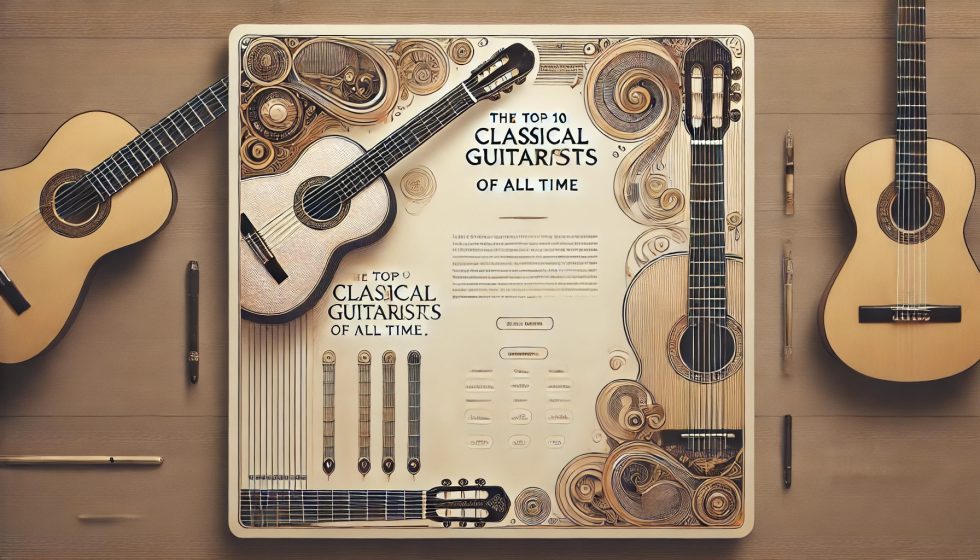
The Top 10 Classical Guitarists of All Time
1. Andrés Segovia
Andrés Segovia (1893–1987) is considered one of the most important classical guitarists in music history. Born in Linares, Spain, he was the key figure who brought the guitar to prominence as a serious concert instrument. Segovia transcribed numerous works from the lute and violin repertoire, expanded the guitar’s literature, and inspired many composers to write for it.
His warm, singing tone, flawless technique, and artistic authority set the standard for generations of guitarists. Through countless concerts and recordings, Segovia firmly established the classical guitar in the world of art music.
2. Francisco Tárrega
Francisco Tárrega (1852–1909) was one of the founders of modern classical guitar playing. Born in Villarreal, Spain, he was not only a remarkable virtuoso but also a significant composer. His best-known works include Recuerdos de la Alhambra, Capricho Árabe, and Lágrima.
Tárrega developed new playing techniques, laid the foundation for the romantic guitar repertoire, and profoundly influenced his students, such as Emilio Pujol and Miguel Llobet. His lyrical musicality and refined tone color shaped the style of many later masters — even Andrés Segovia carried forward Tárrega’s legacy.
3. Julian Bream
Julian Bream (1933–2020) was an English guitarist and lutenist who greatly enhanced the reputation of the classical guitar in the 20th century. He was known for his remarkable stylistic versatility, performing both traditional guitar works and Renaissance and Baroque music on the lute.
Bream collaborated closely with contemporary composers such as Benjamin Britten and William Walton, who dedicated new works to him. His expressive phrasing, rich tone,
4. Ana Vidović
Ana Vidović (born 1980 in Karlovac, Croatia) is one of the leading classical guitarists of her generation. A child prodigy, she began performing publicly at an early age and has won numerous international competitions, including the Francisco Tárrega and Andrés Segovia competitions.
Vidović is renowned for her extraordinary technical precision, clear tone, and deep musical understanding. Her repertoire ranges from Bach and Albéniz to contemporary composers. With her emotional expressiveness and virtuosity, she continues to captivate audiences and critics around the world.
5. Paco de Lucía
Paco de Lucía (1947–2014) was a Spanish flamenco guitarist who blurred the boundaries between flamenco, classical, and jazz music. He is widely regarded as one of the greatest guitarists of all time.
Though rooted in traditional flamenco, he revolutionized the style by incorporating complex harmonies and improvisation, creating what became known as Nuevo Flamenco. His iconic recording Entre dos aguas brought flamenco to international attention. De Lucía collaborated with artists such as John McLaughlin, Al Di Meola, and Chick Corea, and his passionate, technically dazzling playing left a lasting mark on modern guitar music.
6. Alexandre Lagoya
Alexandre Lagoya (1929–1999) was a French guitarist of Egyptian origin. Together with his wife, Ida Presti, he formed the famous duo Presti–Lagoya — one of the most celebrated guitar duos in history.
Lagoya was admired for his brilliant technique, warm tone, and refined musicianship. He performed an extensive repertoire ranging from Baroque to contemporary music and appeared in major concert halls worldwide. In addition to his performing career, Lagoya was also a respected teacher and composer, leaving a lasting legacy in the classical guitar world.
7. Ida Presti
Ida Presti (1924–1967) was a French guitarist who displayed extraordinary musical talent from childhood. Alongside her husband Alexandre Lagoya, she became part of one of the most outstanding guitar duos of the 20th century.
Presti was celebrated for her technical brilliance, musical sensitivity, and the almost vocal expressiveness of her playing. She also composed works for two guitars, such as the Suite pour deux guitares. Although her life was cut tragically short, her artistry continues to inspire guitarists around the world.
8. Antonio Lauro
Antonio Lauro (1917–1986) was a Venezuelan composer and guitarist and is regarded as one of South America’s most important figures in classical guitar music.
He is best known for his Valses venezolanos, including Natalia, Andreina, and Yacambú. Lauro’s music combines classical forms with the rhythms and melodies of Venezuelan folk traditions, exuding both lyricism and rhythmic vitality. His works are now an essential part of the international guitar repertoire.
9. Narciso Yepes
Narciso Yepes (1927–1997) was a Spanish guitarist acclaimed for his technical mastery and musical sensitivity.
He gained international fame in 1947 with his interpretation of Joaquín Rodrigo’s Concierto de Aranjuez — a work he did not compose but helped make world-famous. In 1964, he collaborated with luthier José Ramírez to design the ten-string guitar, which offered a more balanced resonance across registers. Yepes was also known for his interpretations of Baroque music by Bach and Scarlatti, and his recordings remain benchmarks for classical guitarists today.
10. John Williams
John Christopher Williams (born 1941) is an Australian-British classical guitarist widely regarded as one of the most technically accomplished musicians of his field. A graduate of the Royal College of Music in London and a protégé of Andrés Segovia, he became a leading figure in modern guitar performance.
Williams is celebrated for his flawless technique, clarity, and stylistic versatility. His repertoire includes works by Bach, Villa-Lobos, Rodrigo, and Sculthorpe. He also championed contemporary music and collaborated with artists such as Julian Bream and the fusion ensemble Sky. His recordings have shaped the modern perception of the classical guitar more than almost any other artist’s.

















